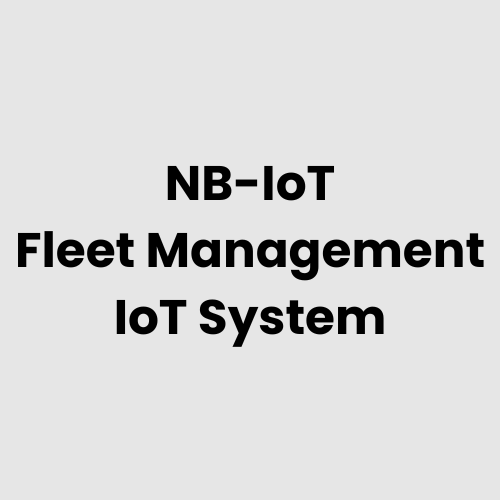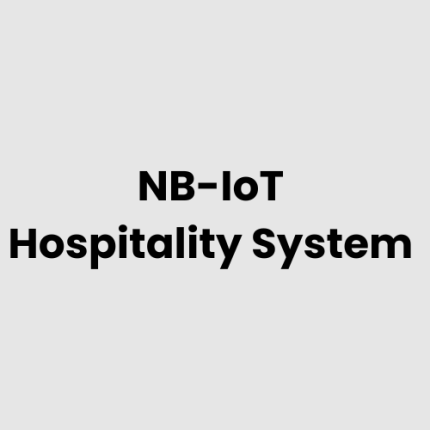Description
The NB-IoT Enabled Fleet Management IoT System leverages advanced IoT technology to streamline fleet operations, optimize vehicle performance, and enhance operational efficiency. The system architecture includes:
- IoT Devices & Sensors: Onboard sensors that monitor vehicle location, speed, fuel consumption, engine health, tire pressure, and driver behavior in real-time.
- NB-IoT Gateways: Gateways aggregate data from onboard IoT devices, and provide secure, reliable communication between the vehicles and the cloud platform.
- Edge Computing Devices (Optional): Local data processing devices within the vehicle that allow immediate analysis and decision-making, reducing latency and bandwidth requirements.
- Centralized Data Platform: A cloud-based platform where data from all vehicles is aggregated and processed, providing fleet managers with real-time insights on vehicle status, driver performance, and maintenance needs.
- Data Analytics & Visualization Tools: Advanced analytics tools that help fleet operators optimize routes, predict vehicle maintenance, and track key performance indicators (KPIs).
- Communication Infrastructure: NB-IoT networks ensure reliable, low-power wide-area communication between vehicles and central systems, even in remote areas with poor connectivity.
List of Hardware for NB-IoT Enabled Fleet Management IoT System
- NB-IoT Sensors: GPS, fuel consumption, engine health, temperature, tire pressure, and accelerometer sensors.
- NB-IoT Gateways: Devices that relay data from IoT sensors to a central platform.
- Edge Computing Devices: Onboard devices for real-time data processing and decision-making.
- Vehicle Tracking Units (VTUs): GPS-based units for real-time location tracking.
- OBD-II (On-Board Diagnostics) Interfaces: Devices to capture vehicle diagnostic data for analysis.
- Communication Modules: NB-IoT communication modules to enable connectivity between vehicles and central systems.
- Centralized Servers/Data Centers: For storing and analyzing fleet data.
- User Interface Devices: For fleet managers to access real-time insights and analytics.
Physical Placement Considerations of Hardware
- Onboard Sensors and Tracking Units: Sensors should be installed on various parts of the vehicle, including the engine, tires, and fuel tank to monitor key parameters. GPS units should be mounted securely on the vehicle to ensure accurate tracking.
- Gateways and Edge Devices: Gateways are typically installed within the vehicle’s dashboard or control unit to ensure seamless communication between sensors and central systems. Edge computing devices should be placed in vehicles where immediate decision-making and data processing are required.
- Centralized Servers: These servers should be housed in secure, reliable data centers with strong network infrastructure to handle large volumes of data from multiple vehicles.
Hardware Architecture
The hardware architecture of the NB-IoT Enabled Fleet Management IoT System consists of:
- IoT Sensors & Devices: Collect vehicle data such as location, engine health, fuel usage, and more.
- NB-IoT Gateways: Bridge communication between vehicles and the central cloud platform.
- Edge Devices: Process data locally for real-time analytics and reduce communication delays.
- Centralized Data Platform: Cloud-based or on-premise servers that aggregate and analyze the data.
- User Interface Devices: These allow fleet managers to access dashboards, reports, and real-time updates on fleet health and performance.
Deployment Considerations
When deploying the NB-IoT Enabled Fleet Management IoT System, the following factors need to be considered:
- Network Coverage: Ensure consistent NB-IoT network coverage across the entire fleet’s operating range, including urban and rural areas.
- Vehicle Integration: Devices should be easily integrated with a wide range of vehicle types, including trucks, vans, and other fleet vehicles.
- Data Security: Implement robust security measures to protect sensitive vehicle and driver data, including encryption, access controls, and secure data transmission protocols.
- Scalability: The system must be scalable to handle fleets of various sizes, from small operations to large enterprises.
- System Integration: The solution should integrate seamlessly with existing fleet management software, ERP systems, and maintenance tools.
- Maintenance & Support: Ongoing support and maintenance are crucial for keeping the system running smoothly. Ensure access to remote or onsite technical support.
Relevant Industry Standards and Regulations
- ISO 39001:2012 (Road Traffic Safety Management Systems)
- ISO 26262 (Functional Safety for Road Vehicles)
- IEEE 802.15.4 (Low-Rate Wireless Personal Area Networks)
- 3GPP NB-IoT Specifications
- GDPR (General Data Protection Regulation)
- FCC Part 15 (RF Devices)
- ELD Mandate (Electronic Logging Devices, USA)
- NHTSA (National Highway Traffic Safety Administration) Regulations
- SAE J1939 (Heavy Duty Vehicle Communications)
Local Server Version
For organizations that require localized data processing, the NB-IoT Enabled Fleet Management IoT System can also be deployed with a Local Server Version. This version involves deploying servers on-site at fleet management facilities, where all data from vehicles is processed and stored locally. This solution offers enhanced control over data security, real-time analytics, and reduced dependency on cloud platforms.
Cloud Integration and Data Management
The NB-IoT Enabled Fleet Management IoT System can be integrated with cloud platforms to provide scalable, real-time fleet tracking and management solutions. In this setup, data from each vehicle’s sensors is transmitted securely to a cloud server where it is processed and analyzed. The cloud infrastructure enables remote access to fleet data, with tools for real-time monitoring, predictive analytics, and performance optimization. This integration provides greater flexibility for fleet managers, allowing them to access data and reports from any location, and provides scalable data storage and processing capabilities. Cloud-based solutions also facilitate system updates and integration with other enterprise software.
GAO Case Studies of NB-IoT Enabled Fleet Management IoT System
USA Case Studies
- New York, NY
A logistics company in New Yorkused an NB-IoT-enabled fleet management system to monitor the location and health of its delivery vehicles. The real-time data provided insights into fuel efficiency, maintenance needs, and driver behavior, helping the company optimize routes and reduce operating costs. - Los Angeles, CA
A fleet operator in Los Angelesintegrated an NB-IoT system to track vehicles in their fleet. By using sensors to monitor vehicle performance, the company improved fleet reliability, reduced downtime, and optimized vehicle maintenance schedules, significantly lowering overall operational costs. - Chicago, IL
A transportation service provider in Chicagoutilized an NB-IoT solution to track vehicles and monitor cargo conditions. The fleet management system helped improve delivery times and ensure that shipments arrived on time and in optimal condition, enhancing customer satisfaction. - Dallas, TX
In Dallas, a logistics firm implemented an NB-IoT-based fleet management system to monitor the real-time location of trucks and their cargo. The system enabled route optimization, reducing fuel consumption and improving overall delivery efficiency by minimizing idle times. - Miami, FL
A transportation company in Miamiused NB-IoT technology to track vehicle performance and optimize fleet routing. With continuous monitoring of fleet status, the company was able to reduce maintenance costs and increase delivery speed, while ensuring the safety of their vehicles. - Houston, TX
A logistics firm in Houstondeployed an NB-IoT system to remotely track the performance and location of vehicles in its fleet. This solution allowed for the timely detection of vehicle issues, reducing downtime and improving operational efficiency. - San Francisco, CA
An e-commerce logistics provider in San Franciscoadopted NB-IoT technology for fleet management. The system provided data on vehicle location, maintenance schedules, and driving behaviors, allowing the company to improve operational efficiency and reduce costs associated with fleet management. - Atlanta, GA
A logistics provider in Atlantaimplemented an NB-IoT fleet management system to monitor driver behavior and vehicle conditions. The real-time data enabled the company to ensure timely deliveries and improve overall fleet health, reducing fuel consumption and maintenance costs. - Boston, MA
In Boston, a delivery service company implemented an NB-IoT-based solution for fleet monitoring. The technology enabled better visibility into vehicle conditions, fuel usage, and travel routes, optimizing the entire fleet’s performance and reducing operational inefficiencies. - Seattle, WA
A transportation and logistics provider in Seattleintegrated an NB-IoT fleet management system to track real-time vehicle locations and monitor environmental conditions for cargo. This helped the company improve dispatch times and reduce delivery delays, enhancing customer service and reducing operational costs. - Phoenix, AZ
A delivery company in Phoenixdeployed an NB-IoT system across its fleet to ensure the optimal performance of vehicles and reduce maintenance costs. By tracking fuel efficiency and vehicle health, the company was able to plan maintenance activities proactively and improve overall fleet reliability. - Washington, D.C.
A government contractor in Washington, D.C.used NB-IoT sensors to monitor fleet vehicles, gaining insights into operational efficiency, including fuel consumption and vehicle performance. The system helped streamline operations and cut costs while ensuring the safety and compliance of the fleet. - Las Vegas, NV
A logistics provider in Las Vegasintegrated an NB-IoT-based fleet management solution to track vehicle health, driving habits, and fuel usage. The company used this data to optimize fleet scheduling, reducing fuel consumption and improving operational efficiency across its fleet. - Orlando, FL
A service provider in Orlandoleveraged NB-IoT technology to track vehicles and optimize fleet maintenance schedules. The system enabled the company to monitor vehicle conditions and reduce unscheduled downtime, helping improve the overall fleet performance and reduce operational costs. - Cleveland, OH
A fleet management company in Clevelandused NB-IoT for real-time vehicle tracking and monitoring. This solution helped the company track driver behavior, monitor fleet conditions, and optimize fuel usage, leading to improved efficiency and reduced fleet maintenance costs.
Canada Case Studies
- Toronto, ON
A logistics service provider in Torontoimplemented an NB-IoT fleet management system to monitor vehicle conditions and fuel efficiency. The system provided real-time data that enabled the company to reduce fuel consumption, optimize vehicle performance, and improve overall fleet management. - Vancouver, BC
A transportation company in Vancouveradopted NB-IoT technology to streamline fleet management. By using IoT-enabled sensors, the company was able to track vehicles’ real-time locations and optimize routes, resulting in reduced fuel costs, improved driver safety, and enhanced fleet productivity.
Navigation Menu for NB-IoT
Navigation Menu for IoT
- LORAWAN
- Wi-Fi HaLow
- Z-WAVE
- BLE & RFID
- NB-IOT
- CELLULAR IOT
- GPS IOT
- IOT SENSORS
- EDGE COMPUTING
- IOT SYSTEMS
Our products are in stock and can be shipped anywhere in the continental U.S. or Canada from our local warehouse. For any further information, please fill out this form or email us.
We are actively looking for partners who are like us located in the U.S. and Canada. For more information on partnering with GAO, please visit Partner with GAO Tek Inc.It lists various ways to partner with GAO, such as OEM Partnerships, Technology Integration, Distribution and Reselling Opportunities, Presenting at the Leading Event Tek Summit, Joint R&D Projects, Training and Consulting Services, Industry-Specific Collaborations, Research and Academic Partnerships.



